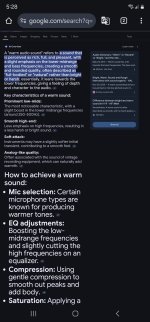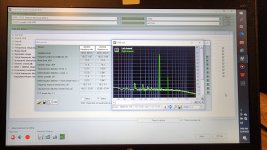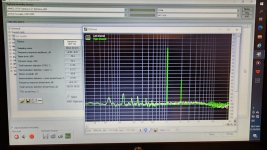The P3A doesnt have a superior PSRR, thus it is sensitive to the quality of the power supply. I replaced 0.1F RC supplies with R21 modules
(see https://www.diyaudio.com/community/...crc-power-supply-r21-ps-module.376003/page-10)
and was very pleased with the sound improvement.
(see https://www.diyaudio.com/community/...crc-power-supply-r21-ps-module.376003/page-10)
and was very pleased with the sound improvement.
Another thing suggested is to use a combination of ceramic and metal film resistors, rather than full metal film, even though it will slightly affect precision it will also slightly introduce a tiny bit of pleasant distorsion. Also to use electrolytics instead of Polyprop for the same reason.
Are you sure the suggestion wasn't for carbon film resistors rather than ceramic?
How did it sound then?If anyone can provide a definition of that “warm” sound, please let me know. I once created a simple little DSP application that allowed me to add a variable amount of second harmonic to a signal. And whatever it is, the “warm” sound ain’t that. It sounded anything but warm.
Please do not touch the amplifier. Instead, use variable loudness to add some richness in lower bass. There were many threads about loudness control, I suggest the one which has separate volume pot and separate variable loudness. You can dial in any amount of richness you like.Hello,
I have built the P3A several years ago, but for my taste, the sound is too clinical. I understand it is built for precision, and it does that very well, but it lacks the "warmth" that usually comes tweaked for branded amps. This warmth, as far as I understand, comes from an emphasis on bass and highs, with a decreased representation of the mid end, making it sound less-harsh and less-tiresome. ( like a V shaped equalization pattern ). So, I was thinking of making some adjustments, and with the help of Chat GPT, I identified some possible mods that I can make, but I would love it if anyone here had the time to validate if these can cause other issues with the amp and if these will actually affect the sound signature towards "warmth" :
low end :
- increase C1 from 4.7 to 10 or even 22
- increase C2 from 100 to 220pf or even 470pf
- increase C3 from 100 to 220 or even 470
- increase C5 from 100 to 220 or even 470
- reduce R6 from 560 to 470 ( will this affect the recommended bias value ? )
- C+, C- increased from 100 to 470 or even 1000
high end :
- increase C4 from 100 to 150pf or even 220pf
- reduce R11 and R12 from 220 to 180 ( same question, will this affect recommended bias ? )
- add 2.2nF capacitor in parallel with R5
It was also suggested to increase R13 and R14 to 0.47 or even 0.56 to tone down the vocals
Another thing suggested is to use a combination of ceramic and metal film resistors, rather than full metal film, even though it will slightly affect precision it will also slightly introduce a tiny bit of pleasant distorsion. Also to use electrolytics instead of Polyprop for the same reason.
What of these advices do you think are feasible ?
Thanks in advance !
View attachment 1415221
I still have very old JVC hifi from my teanage years, it has independent loudness pot. I used to have parrasound preamp with the same function.
Its completely passive circuit, which you just insert between the dac and amp. No need to touch the dac or amp.
Last edited:
Other option is to insert small active eq. I use schiit loki mini+, its an amazing little eq, inexpensive, but exceptionaly well designed. They do have bigger more expensive eq, i have not tried yet.
We are quite good in finding solutions for non existing problems here but what about connecting old “warm” loudspeakers with woven tweeters to that P3A? If ChatGPT agrees with that of course, we don’t want trouble with the authorities.
Sharp and harsh. Like I added an octave above the original sound. 😀How did it sound then?
🤣If ChatGPT agrees with that of course, we don’t want trouble with the authorities.
Weird, second harmonic addition never sounds harsh. I have test cd for testing distortion detection, with series of second harmonic and addition of second harmonic makes all sound mellow. Tones with third sound sharp.Sharp and harsh. Like I added an octave above the original sound. 😀
To me right combination of second (higher) and third (slightly lower in level) sounds best. Assuming absence of upper odd harmonics.
Situation with second harmonic can be more complex depending phase it is. Read what Nelson Pass reports about it.
I got preamps with barely measurable distortion (~0.0002%) which sounds like crap, and plenty of tube preamps with beatiful musical sound with ~0.02% distortion.
But second harmonic never sounds sharp and harsh.
This is simple jfet pre hamptone. Well known for sweet sound. Pure second harmonic.
Attachments
Please post fft spectra of 1kHz test tone before and after your dsp.Sharp and harsh. Like I added an octave above the original sound. 😀
Otherwise adding octave above is enriching, hardly noticable at low level. Never sharp and harsh.
Last edited:
Just joking. It is a typical German word spoken in the way of its meaning. Like rau with rolling r (raw).
The DSP in that test rig has been repurposed for another experiment, so it will take me a while to get it up and running again. I'll see if I have screenshots somewhere. If my memory serves me right, it wasn't noticeable at first, but when it was, it wasn't pleasant. At least not to my ears.Please post fft spectra of 1kHz test tone before and after your dsp.
Otherwise adding octave above is enriching, hardly noticable at low level. Never sharp and harsh.
- Home
- Amplifiers
- Solid State
- Rod Elliot P3A modification questions



